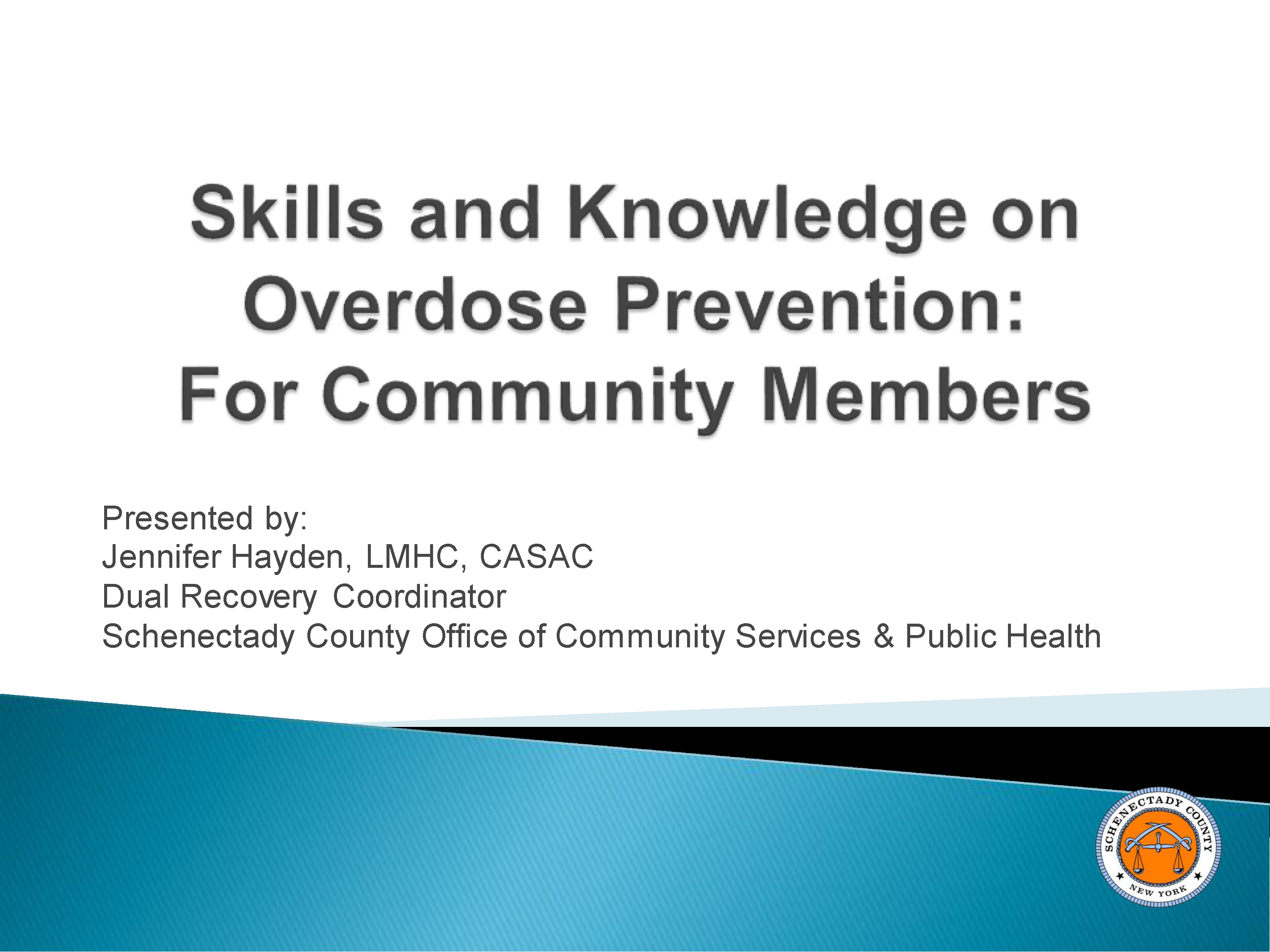Naloxone Training
Get Trained To Administer Naloxone and Save Lives!
Do you, a loved one, colleague, friend, or neighbor struggle with opioid use disorder? Schenectady County Public Health Services can help educate and train you and the community on opioid overdose prevention, including the use of Naloxone (brand name: Narcan).
Public-facing professionals like police officers, firefighters, employees and managers, teachers, and health professionals should be trained to administer Naloxone. Community leaders and members who are around people who use drugs, especially parents, and caregivers should consider being trained.
Training is FREE for Schenectady County Residents and Employees
Watch the online training video and learn how to respond to a suspected overdose and administer Naloxone.
UPCOMING IN-PERSON NALOXONE TRAINING
An opioid overdose happens when the amount of drugs like Heroin, Fentanyl, OxyContin, Percocet, Vicodin, Methadone, or a mixture of them is too high in someone’s body. The person becomes unresponsive and/or has extremely shallow breathing.
Signs of an Overdose:
- Unresponsive (not responding, not reacting, or not answering)
- Something wrong with breathing (shallow or no breathing; breathing is often noisy: snoring, gurgling)
- Blue around lips
- Nail beds lose pink color
- Eyes with pinpoint pupils
- Your intuition says: This is an overdose
Naloxone (brand name: Narcan) reverses overdoses due to opioids (i.e. Heroin, Fentanyl, OxyContin, Percocet, Vicodin, Methadone). It wakes the person up from an opioid-related overdose within minutes. It blocks the opioids from working within the body for 30-90 minutes. This may cause withdrawal if the person who overdosed has built up a tolerance to opioids. Administering Naloxone/Narcan will not cause harm, even if the person is not experiencing an opioid overdose. Do not hesitate because you are not sure if the overdose was caused by an opiate. The most important thing is to get the person’s breathing back to normal.
Put the person on their back with head tilted back so that the naloxone does not run down out of the nose
- Do not test the device before using
- Peel away the packaging, place the plunger deep in the nose, and press
- When the person wakes up, explain what happened and that you gave them naloxone. (“You were not breathing, and I gave you naloxone.”)
- Advise the person against using any more drugs now. (“Naloxone will prevent the drugs you take from working. Taking more will be dangerous causing you to overdose again when the naloxone wears off.”)
- Let them know help is on the way and if they are feeling withdrawal, it should wear off in 30-90 minutes.
If 911 was not called immediately:
- If the person is not fully awake, walking and talking, call 911 or take them to the ER.
- If the person is not in withdrawal or is managing the effects of withdrawal well, stay with the person at least 3 hours, until after the naloxone has fully worn off. This is so you can watch for return of overdose.
- Shout "Hey! Are you OK?"
- Shake the person
- Apply painful stimulation - use “sternal rub” a.k.a. “sternal grind” which means to press and move your knuckles up and down the person’s chest to get a response
- Call 911 AND administer naloxone. BOTH are essential. Whichever is quickest to do first.
- If the person has not started breathing normally after 3 minutes, administer naloxone again.
- If the person begins to breathe but cannot get up, place the person in the recovery position laying down and on their side.
- If the person has not begun to breathe, do rescue breathing and/or chest compression if you know how.
- 2 nasal naloxone pumps
- Testing strips for Fentanyl and Xylazine
- Infographics that show how to use Naloxone and what to do
- Gloves
- Blue card with certification and expiration date for the kit
Why is it important to get trained in overdose prevention and naloxone?
It's crucial to take steps to prevent overdose or death, such as testing drugs to ensure they aren't laced or contaminated, avoiding solo usage, and making sure that many people are equipped to give Naloxone.
After you complete the online training you can receive a Narcan Kit. Narcan Kits contain two Naloxone pumps, gloves, and testing strips for Fentanyl and Xylazine. When using alone, call the Never Use Alone hotline 1-800-484-3731.
In this 25-minute video you will learn:
- How to recognize an overdose
- How to respond to a suspected overdose
- How to administer Naloxone (Narcan)
You will also receive information on the Naloxone Co-payment Assistance Program and other related resources.
To obtain a Naloxone (Narcan) Kit, complete the form below after completing the online training video. A member of the Schenectady County Public Health Services Community Health Division will reach out and give you a kit.
Please be advised that this program does not constitute medical education for providers in terms of clinical certification.
Receive a Narcan Kit
Watch the Online Video Training and complete the following form to receive a Narcan Kit. The Schenectady County Public Health Services Community Health will contact you and give you a kit.

-dp7ylv.png)
-jsfm6h.png)
-2r9p4x.png)
-km2ife.png)
-d42hb9.png)
-wvt46q.png)




